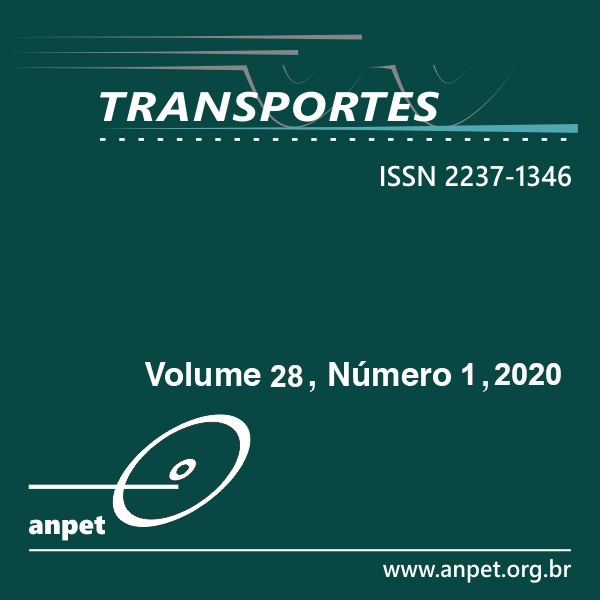Avaliação das emissões de co2 na etapa de transporte do etanol: aplicação de um modelo de otimização
DOI:
https://doi.org/10.14295/transportes.v28i1.1856Keywords:
Transport planning, Logistics, Operational research, Biofuels.Abstract
Recently, the Brazilian government launched the Renovabio program, aiming to increase the share of ethanol in the light vehicles fuel demand and help achieve the greenhouse gas emission cutting goals established in the Paris Agreement. The success of this program could be enhance due to a pipeline network project that is being implemented, for the reason that this infrastructure could provide a lower cost logistic alternative for the ethanol distribution with a very low GHG emission. Considering this context, this paper proposes the development of a linear programming model applied for optimizing ethanol transportation flows and measure accurately the CO2 emissions resultant of the ethanol transport operations, as well as to evaluate the impact of the implementation of this pipeline network project in mitigating CO2 emissions and reducing transport costs. The results showed that the full implementation of this pipeline has the potential to reduce CO2 emissions by 14% and achieve savings around R$ 136 million per year in the transportation costs of ethanol production. The method proposed in this work contributes for the evaluation of the economic impact and the mitigation of GHG caused by new transport infrastructures.Downloads
References
Andriolli, M. (2009) Análise de viabilidade econômico-financeira de alcoodutos no Brasil. Universidade de São Paulo, Piraci-caba. Obtido de http://www.teses.usp.br/teses/disponiveis/11/11132/tde-14042009-160143/.
ANFAVEA. (2018) Anuário da Indústria Automobilística Brasileira. Obtido de http://www.anfavea.com.br/anuarios.html.
ANP. (2016a) Vendas de derivados de petróleo e etanol. Obtido de http://www.anp.gov.br/dados-estatisticos.
ANP. (2016b) Relação de bases de distribuição de combustíveis líquidos autorizadas a operar. Obtido 2 de abril de 2017, de www.anp.gov.br/wwwanp/?dw=35226.
ANTT. (2016) Declaração de Rede. Obtido 20 de junho de 2017, de http://www.antt.gov.br/fer rovi-as/Declaracao_de_Rede_Geral.htmla.
APAS. (1996) Transport Estrategic Modelling. Luxemburgo.
Avileis, F. G. (2014) Impactos da logística na precificação do etanol: um estudo de caso sobre a dutovia. Piracicaba. Obtido de http://esalqlog.esalq.usp.br/.
BOVOLENTA, F. C., e BIAGGIONI, M. A. M. (2016) Diagnóstico energético de rotas de escoamento do etanol da região centro-oeste do brasil para exportação. Engenharia Agrícola, 36(3), 408–419. DOI:10.590/1809-4430.
Branco, J. E. H., Branco, D. H., Aguiar, E. M. de, Caixeta Filho, J. V., e Rodrigues, L. (2019) Study of optimal locations for new sugarcane mills in Brazil: Application of a MINLP network equilibrium model. Biomass and Bioenergy, 127, 105249. DOI:10.1016/j.biombioe.2019.05.018.
BRASIL. Ministério do Meio Ambiente. (2013) Inventário Nacional de Emissões Atmosféricas por Veículos Automotores Rodoviários.
BRASIL. Ministério da Agricultura, P. e A. S. de P. e A. D. de C. e A. (2016) Produção Brasileira de Etanol. Obtido 11 de fevereiro de 2018, de http://www.agricultura.gov.br/assuntos/sustentabilidade/agroenergia/arquivosproducao/PRODUOBRASILEIRADEETANOLatualizadoem19062018.pdf.
BRASIL. Ministério de Minas e Energia. (2018) Programa Renovabio. Obtido 21 de junho de 2018, de http://www.mme.gov.br/web/guest/secretarias/petroleo-gas-natural-e combustiveis-renovaveis/programas/renovabio/principal.
Brassolatti, T. F. Z., Hespanho, A. P., Costa, M. A. B., e Brassolatti, M. (2017) Etanol de Primeira e Segunda Geração. Revista In-terdisciplinar de Tecnologias e Educação, 2(1), 1–9.
Costa, W. R. (2013) Capacidade estática para etanol dos Portos Brasileiros: Santos e Paranaguá. Piracicaba.
DEPARTAMENTO HIDROVIÁRIO. (2009) “Hidroanel Metropolitano & Dinamização da Hidrovia Tietê - Paraná”. São Paulo.
Carmo, V. B. (2013) Avaliação da Eficiência Energética Renovável de Biomassas Alternativas para Geração de Eletricidade. Faculdade de Engenharia Química, Universidade Estadual de Campinas.
EPE. (2017) Balanço Energético Nacional 2017: Ano base 2016. Rio de Janeiro. Obtido de https://ben.epe.gov.br/downloads/Relatorio_Final_BEN_2017.pdf
ESALQ-LOG. (2017) Consumo de combustível no transporte rodoviário.
Friesz, T. L., Tobin, R. L., e Harker, P. T. (1983) Predictive intercity freight network models: the state of the art. Transportation Research Part A: General, 17(6), 409–417. DOI:10.1016/0191-2607(83)90161-9.
Garrido, R. A., e Mahmassani, H. S. (2000) Forecasting freight transportation demand with the space-time multinomial probit model. Transportation Research Part B: Methodological, 34(5), 403–418. DOI: 10.1016/S0191-2615(99)00032-6.
LOGUM. (2017a) Quem somos. Obtido de http://www.logum.com.br/php/quem-somos.php.
LOGUM. (2017b) Sistema Logístico de Etanol. Obtido 15 de junho de 2017, de http://www.logum.com.br/php/o-sistema-logum.php.
Macedo, I. C. (2007) Situação atual e perspectivas do etanol. Estudos avançados, 21(59), 157–165.
Milanez, A. Y., Nyko, D., Garcia, J. L. F., e Xavier, C. E. O. (2010) Logística para o etanol: situação atual e desafios futuros. BNDES Setorial, 31, 49–98.
MME - Ministério de Minas e Energia. (2018) Programa Renovabio. Obtido 21 de junho de 2017, de http://www.mme.gov.br/web/guest/secretarias/petroleo-gas-natural-e combustiveis-renovaveis/programas/renovabio/principal.
NOVACANA. (2017) Etanol (Álcool): tudo sobre esse biocombustível. Obtido 21 de junho de 2017, de https://www.novacana.com/etanol/.
Pinheiro, M. A. (2012) Estimativa da redução das emissões gases de efeito estufa através da intermodalidade no setor sucro-energético: uma aplicação de programação linear. Universidade de São Paulo, Piracicaba. Obtido de http://www.teses.usp.br/teses /disponiveis/11/11132/tde-31052012-085545/.
Rodrigues, S. B. M. (2007) Avaliação das alternativas de transporte de etanol para exportação na região Centro-Sul. Universidade de São Paulo, São Carlos. Obtido de http://www.teses.usp.br/teses/disponiveis/18/18144/tde-07042008-114034/.
SECEX. (2016) Aliceweb. Obtido de http://aliceweb.mdic.gov.br/.
SIFRECA. (2017) Fretes rodoviários de etanol - 2016.
Silva, R. F. da, Péra, T. G., Bacchi, D. B., Caixeta-Filho, J. V., e Cugnasca, C. E. (2013) Modelo matemático de transporte para ava-liação dos ganhos econômicos no transporte hidroviário e dutoviário de etanol. Congresso de Pesquisa e Ensino em Transportes (ANPET) (p. 15–27). Belém. Obtido de http://www.anpet.org.br/ssat/interface/content/autor/trabalhos/publicacao/2013/440_AC.pdf.
UNICA. (2017) RenovaBio: Cenários e Simulação de Impacto. Obtido de http://www.unica.com.br/renovabio/.
Vaz, A. V., Oliveira, K. N., e Damasceno, P. E. (2005) O modal dutoviário: análise da importância e considerações sobre suas principais características. Fortaleza.
Xavier, C. E. O. (2008) Localização de tanques de armazenagem de álcool combustível no Brasil: aplicação de um modelo matemático de otimização. Universidade de São Paulo, Piracicaba. Obtido de http://www.teses.usp.br/teses/disponiveis/11/11132/tde-17072008-152340/.
Alessandri, A., A. Di Febbraro, A. Ferrara and E. Punta (1998) Optimal Control of Freeways via Speed Signalling and Ramp Metering. Control Engineering Practice, v. 6, n. 6, p. 771–780. DOI: 10.1016/S0967-0661(98)00083-5.
Downloads
Published
How to Cite
Issue
Section
License
Authors who submit papers for publication by TRANSPORTES agree to the following terms:
- The authors retain the copyright and grant Transportes the right of first publication of the manuscript, without any financial charge, and waive any other remuneration for its publication by ANPET.
- Upon publication by Transportes, the manuscript is automatically licensed under the Creative Commons License CC BY 4.0 license. This license permits the work to be shared with proper attribution to the authors and its original publication in this journal, and to be adapted for non-commercial purposes, provided appropriate credit is given and any derivative works are distributed under the same terms.
- Authors are authorized to enter into additional separate contracts for the non-exclusive distribution of the version of the manuscript published in this journal (e.g., publishing in an institutional repository or as a book chapter), with recognition of the initial publication in this journal, provided that such a contract does not imply an endorsement of the content of the manuscript or the new medium by ANPET.
- Authors are permitted and encouraged to publish and distribute their work online (e.g., in institutional repositories or on their personal websites) after the editorial process is complete. As Transportes provides open access to all published issues, authors are encouraged to use links to the DOI of their article in these cases.
- Authors guarantee that they have obtained the necessary authorization from their employers for the transfer of rights under this agreement, if these employers hold any copyright over the manuscript. Additionally, authors assume all responsibility for any copyright infringements by these employers, releasing ANPET and Transportes from any responsibility in this regard.
- Authors assume full responsibility for the content of the manuscript, including the necessary and appropriate authorizations for the disclosure of collected data and obtained results, releasing ANPET and Transportes from any responsibility in this regard.









